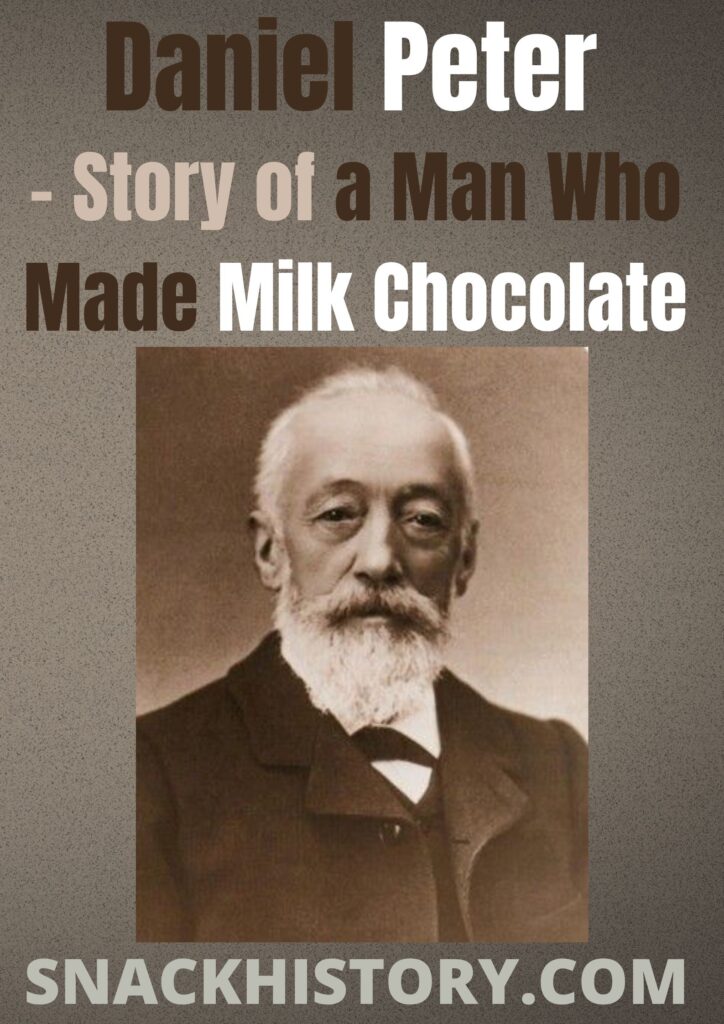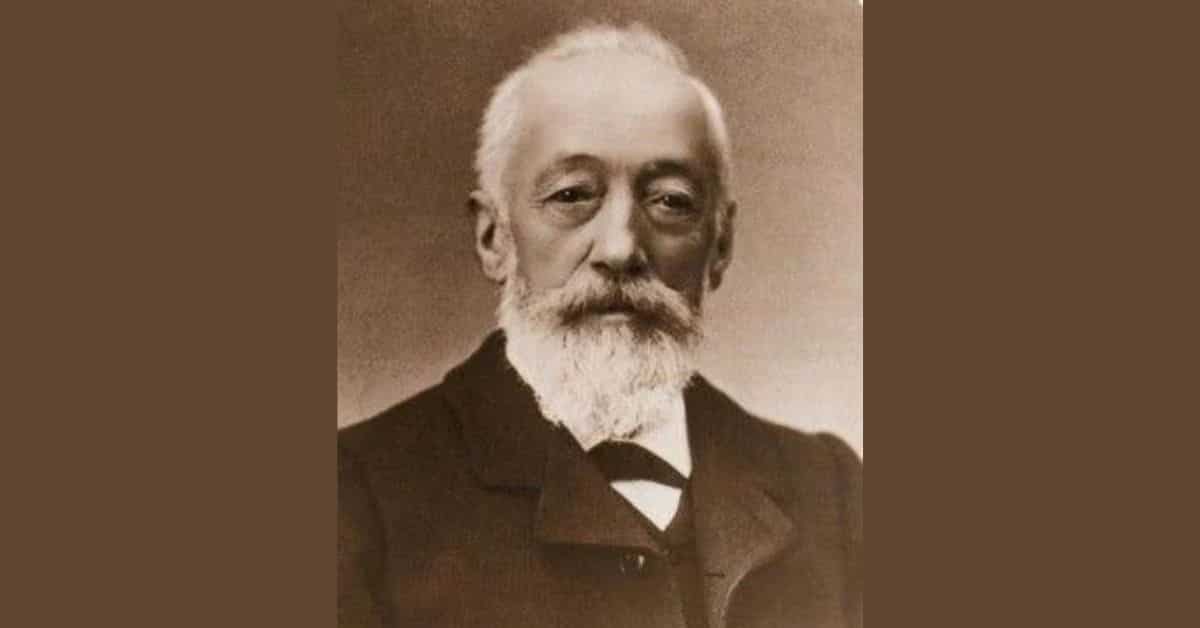Daniel Peter – Story of a Man Who Made Milk Chocolate
Who would have imagined that Switzerland, a country without a single homegrown cocoa bean, would become one of the world’s leading chocolate manufacturers? But surprisingly, one man from a small village changed the whole chocolate industry – and for this, we should probably be most grateful to Daniel Peter.
Today most candy and chocolate companies produce various types of milk chocolate bars. But did you know that the idea of milk chocolate belongs to one man? Thanks to the creative ideas of Daniel Peter, today candy lovers have an opportunity to taste Cadbury Dairy Milk, Milka, Dove Chocolate Bar, and numerous other chocolates with milk.
Please leave a review or any memories of this snack in the comments at the bottom of this page. Thank you!
Let’s dive deep into the story of Daniel Peter and see how the history of milk chocolate began.

A Young Man From Switzerland
Daniel Peter was born in Switzerland, in the village of Moudon, on March 9th, 1836. His parents were Jean Samuel Peter, a butcher, and Jeanne-Louise Laurent. Peter attended and graduated from school there. Even at his young age, one could see that he was an enthusiastic and hard-working person. At the age of 19, he was assigned to lead a Latin class because his professor became ill and someone should have replaced him. He did a really good job, even though he had to work with people his age.
In the summer of 1852, Peter worked for the widow, Madame Clement, at her local grocery store, who also owned a local candle factory. It was here that Daniel Peter’s conscientious, dedicated work qualities were first clearly demonstrated, and he earned the respect of Madame Clement. Four years later, Daniel and his brother, Julien, ran a candle factory, while Madame Clement retained control of it.
The two brothers designed and improved the candles, which were the only light source in history at the time and sold well locally. So he started out as a candlemaker by trade but soon had to diversify his business because of the invention of kerosene lamps, which caused a downturn in the popularity of candles, leading him to find another use for his candle factory.
How It All Started
It was not until his marriage that Daniel Peter started taking the chocolate industry seriously. In 1863, he married Fanny-Louise Cailler, a daughter of François-Louis Cailler, who was also a chocolate maker. After their marriage, Daniel became more interested in the chocolate business as a possibility in his factory. He believed in the success of the chocolate business and thought that Cailler’s business could not keep up with the demand.
And one day, he realized he needed to change his life. He found a completely new purpose and decided to start his own business. By doing so, he would become a competitor to his wife’s family. Although he had the full support of his beloved wife, that was definitely a big motivation for him, which encouraged him to keep up with his goals.
As a result, in 1867, Daniel Peter founded his own chocolate company in Vevey. Interestingly, during this period, Daniel Peter, in order to learn as much as possible about the chocolate business, worked for a few weeks in France, in Lyon, collaborating with a chocolate factory. He spent his evenings and weeks documenting the technical questions raised in chocolate production, allowing him to learn the mechanics and chemistry of the business. Besides, he studied the cocoa harvest and transportation of the basic cocoa ingredients from the tropics. All these “working on himself” strategies underlined his deep interest in this business.
However, the business was not going so well, so he started looking for ways to improve it. Daniel Peter knew for sure that if he wanted to place himself among the existing chocolate factories, he had to think of something special. He had to work a lot to compete with other factories like Caliller, Suchard, Kohler, and others that were already standing firmly in the chocolate business. He knew that he needed a new, distinguished product that would satisfy all the chocolate lovers.
Searching for Solutions
This was the time when Daniel Peter formed a strong friendship with his neighbor, Henri Nestle, who had developed a process of making baby food in which he used what was then called “milky flour.” Henri helped them a lot when he suggested giving milk food to Daniel and Fanny’s firstborn child, who had a breastfeeding problem. That was the time when Daniel Peter had an idea of making chocolate-containing milk, and soon after he became obsessed with it.
But it was not that easy to make it a reality. Daniel Peter knew that it was a big challenge, and he was ready for it. At first, it even looked impossible, but he wasn’t going to stop.
Fortunately, he did not give up and started to search for solutions. In the beginning, as a result of the first try, he got a product that consisted of cocoa, sugar, and milk, which was different from the baby milk flour used by Nestle, which consisted of wheat flour. Generally, wheat flour has a slightly fatty body, while cocoa, mainly used as an ingredient in chocolate, depending on its source and the degree of ripeness of the harvested grains, contains 45% to 55% of the fat.
Inspiration Finally Approached
It is a well-known fact, and even during this period, everybody knew that water and fat do not mix with each other. Due to the instability of the mixture, the product simply would not work. A certain percentage of fat had to be removed from the cocoa beans, which was not a difficult process. The main challenge was to dehydrate as much as possible of the water content of the milk. After hard work and trying, he reached perfection and dehydrated the milk to prevent spoilage. Previous attempts to use whole milk with cocoa failed because the milk’s high water content turned the chocolate rancid.
According to him, in the beginning, tests did not succeed; he couldn’t get the milk chocolate that would satisfy the needs of people. After so many tests, he finally found the proper mixture of cocoa and milk, but happiness didn’t last too long. A few weeks later, as he examined the contents, an odor of bad cheese or rancid butter came to his nose. ” I was desperate, but what was I to do? Do I go back and try a different procedure? Being as it was, I did not lose courage, but I continued to work as long as circumstances allowed.” – he says.
However, the results of tests conducted by Daniel Peter to produce milk chocolate weren’t all failures and finally improved. Peter asked his agents to take his product for sale to cooler and drier places. Interesting is the fact that Daniel Peter sold a small quantity which he personally guaranteed to refund if the goods were found to be unsatisfactory.
After a while, Daniel Peter received the unsold goods back. It had become rancid, and he had received some unflattering commentary from his outlets. It turned out that the milk from Guin was not sufficiently condensed, and therefore, Peter hesitated to order more until he had achieved his goal for milk chocolate. He needed to avail himself of a proper vacuum with other supporting equipment, which he could not afford at that time.
It worked!
Peter then set up a small room, which he called the “drying room,” where the product he made was turned into flakes, spread on drawers, and subjected to high temperatures for further evaporation. To determine the amount of evaporation, this material was weighed before and after exposure. The result was favorable for Peter. He was sure he was close to the goal, and this time, he was right.
Finally, in 1875, after seven years of effort, he eventually reached his goal, solved the problem, and milk chocolate was ready to conquer the world! It was an immediate hit across Europe. His milk chocolate became a sensation, embraced by European chocolate connoisseurs and rewarded with a slew of awards. In 1879, Daniel and Henri Nestlé joined forces to form the Nestlé company and brought milk chocolate to the mass market.
Daniel Peter changed the flavor of chocolate around the world and developed a new culture of chocolate making. In 1887, Daniel Peter adopted the original formula, which later became the first successful milk chocolate in the entire world. The product was called “Gala“, which in Greek means -“from the milk.” Daniel Peter worked in the Nestle factory in Vevey, Switzerland until he was in his 90’s.
Daniel Peter Creates A New Era in the Chocolate Industry
Milk chocolate, invented by Daniel Peter, changed the industry of chocolate making. In modern times, major milk chocolate producers include Ferrero, Hershey, Mondelez, Mars, and Nestle. They are responsible for over half of the chocolate sold worldwide, and they all stand on the idea of mixing milk with cocoa, thanks to Daniel. Cadbury dairy milk and Hershey bar became mainstream at the beginning of the twentieth century following the launch of Cadbury dairy milk and Hershey bar.
At the same time, milk chocolate was combined with other ingredients, like nougat, to form a wide variety of bars, including Toblerone in 1908, Goo Goo Cluster in 1912, and Kit Kat in 1935. Nowadays, our favorite chocolate sweets, like M&Ms, Almond Joy, Hershey Bar, Milky Way, etc., consist of milk. That changes the taste of the chocolate radically, as we love it. Can you imagine the world without them? All the credit for this goes to Daniel Peter, the man from Switzerland’s little village, who tried and tried again, and with seven years of hard work, created the sensation – chocolate with milk, which keeps alive the whole chocolate industry even today.

Nato is a content writer and researcher with a background in psychology. She’s passionate about writing about the candy industry and exploring the cultural significance of sweets and treats. She believes that the stories behind our favorite snacks can reveal a great deal about our values.
Please leave a review or any memories of this snack in the comments below. Thank you!
Click here for a full A-Z list of Snacks and Candy
